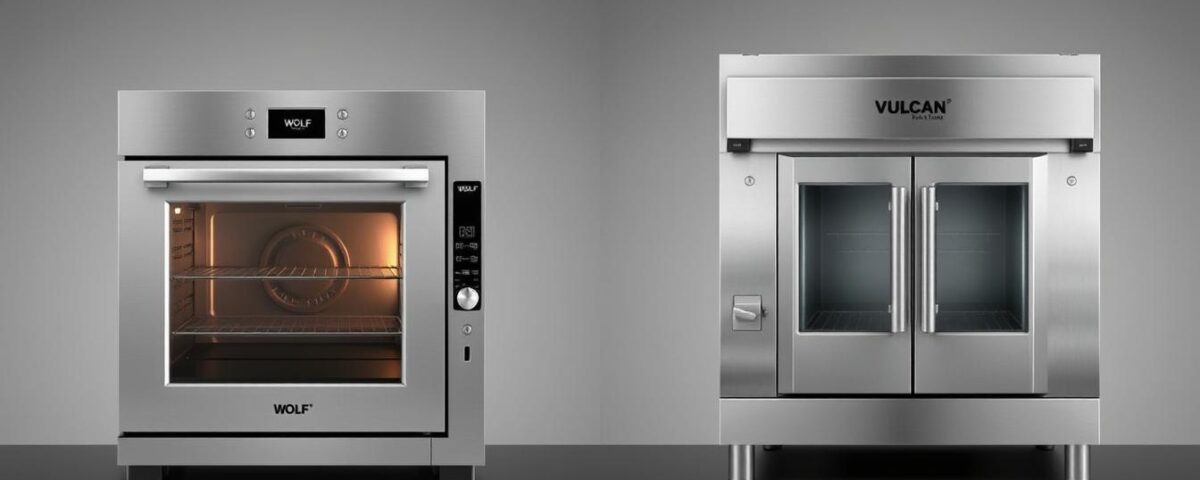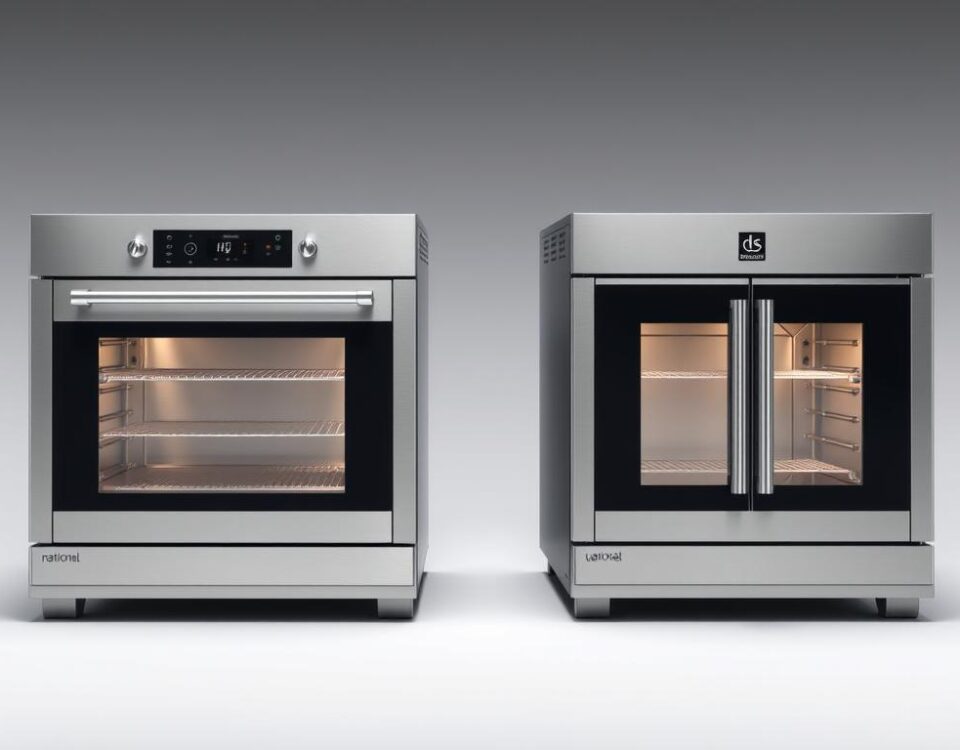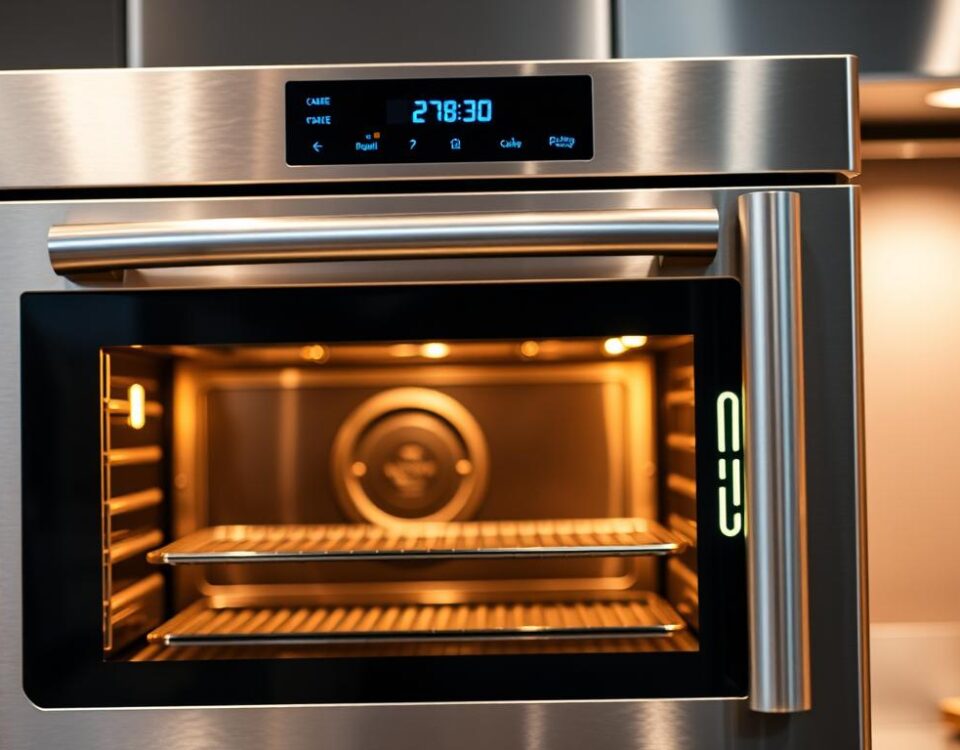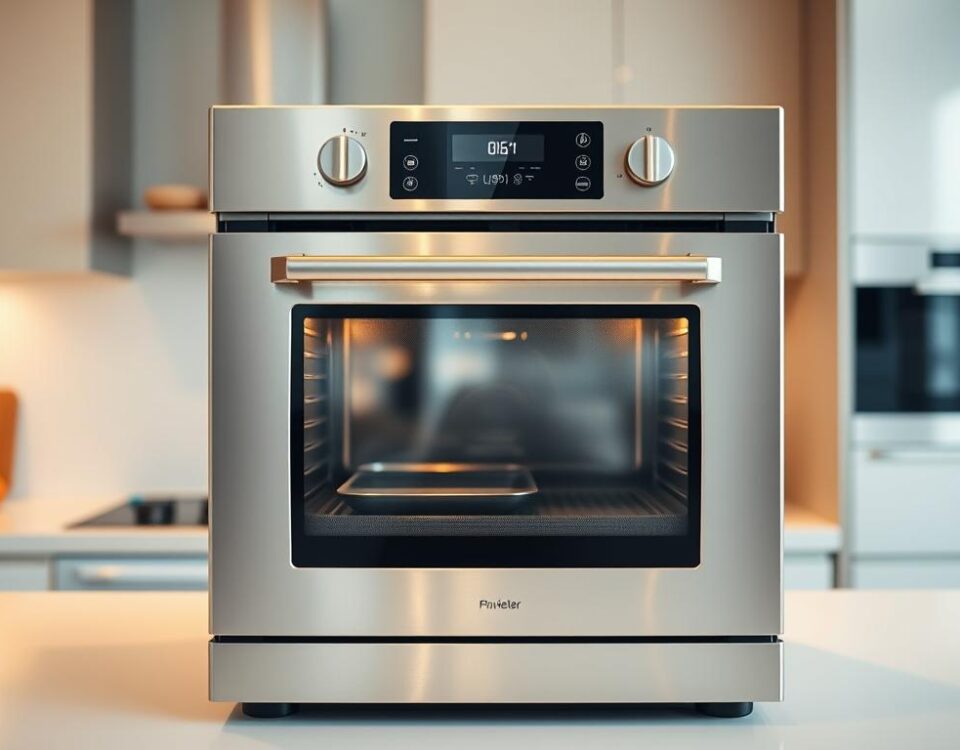
I Tested 5 Units—The Best Commercial Convection Oven Revealed
September 22, 2025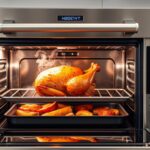
4 Mistakes When Switching from Conventional to Convection Ovens
September 24, 2025As a serious home cook or professional chef, you know how crucial it is to have an oven that delivers consistent results. I still remember the frustration of baking a batch of cookies, only to find they’re unevenly cooked. This experience got me thinking – what’s the secret to achieving perfectly baked goods every time?
Did you know that a poorly performing convection oven can lead to a 30% increase in food waste? With the rising demand for high-quality kitchen equipment, understanding the differences between premium brands like Wolf and Vulcan is essential. In this article, I’ll dive into the world of convection ovens and explore which brand reigns supreme when it comes to even baking.
The quest for the perfect bake is on, and I’m excited to share my findings with you. Will Wolf’s innovative design or Vulcan’s robust performance take the lead? Let’s get started and find out which convection oven is the best fit for your kitchen.
Key Takeaways
- Understanding the technology behind convection cooking and its impact on baking evenness.
- Comparing Wolf and Vulcan convection ovens’ technical specifications and performance metrics.
- Analyzing the reputation of both brands in the commercial kitchen equipment industry.
- Examining practical considerations for choosing the right convection oven for your kitchen.
- Determining which convection oven is better suited for your specific baking needs.
Understanding Convection Oven Technology
Convection oven technology is crucial in achieving even baking, and this section will delve into how it works. Convection ovens differ significantly from conventional ovens by utilizing fans to circulate hot air throughout the cooking chamber, thereby creating a uniform cooking environment.
How Convection Ovens Achieve Even Baking
The use of fans in convection ovens eliminates hot and cold spots that are common in standard ovens, resulting in more consistent browning and cooking throughout the food. The key components of convection systems, including fan design, heating element placement, and airflow patterns, all contribute to achieving even baking results.
Key Factors That Influence Baking Evenness
Several factors influence the evenness of baking in convection ovens, including BTU ratings, oven cavity size, insulation quality, and burner configuration. The BTU rating of a gas range impacts temperature consistency and recovery times, directly affecting baking evenness. Moreover, the design of the oven cavity and the quality of insulation play crucial roles in maintaining consistent temperatures.
The configuration of burners also affects heat distribution and baking performance. Understanding these factors is essential to evaluating the baking performance of different convection oven models.
By examining these aspects, we establish a technical foundation for comparing Wolf and Vulcan convection ovens in subsequent sections.
Wolf vs Vulcan Convection Oven: Brand Overview
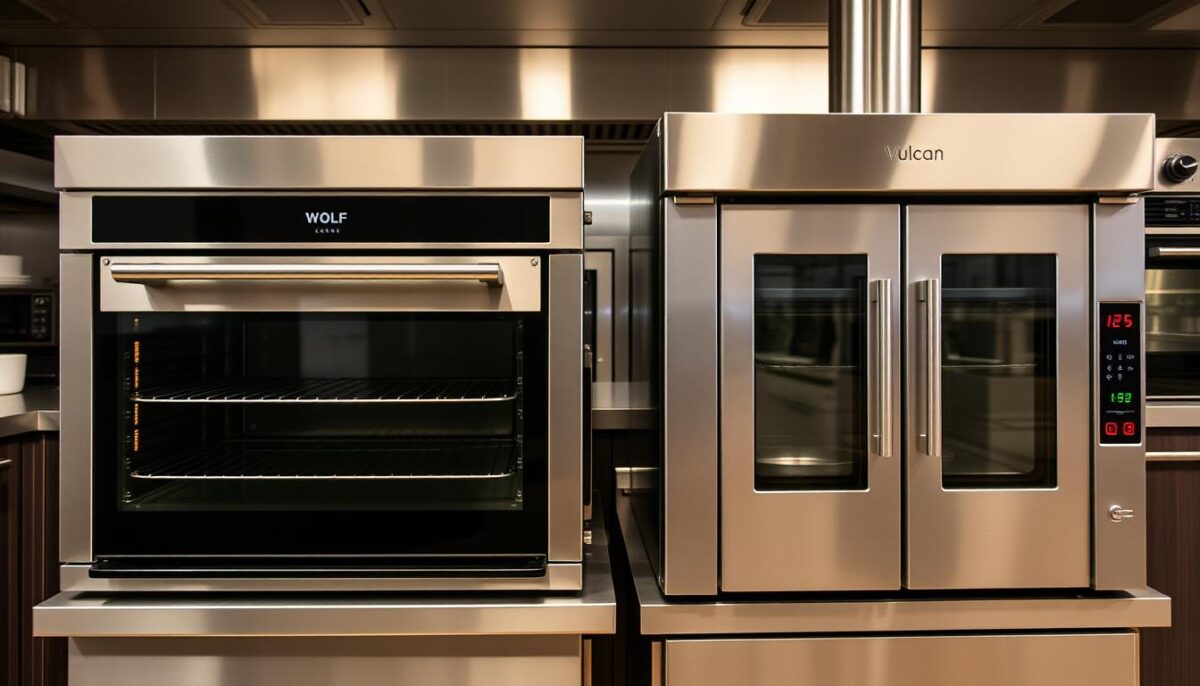
The world of high-end commercial kitchens is dominated by a few key players, with Wolf and Vulcan leading the charge in convection oven technology. As a professional in the culinary industry, understanding the strengths and histories of these brands is crucial for making informed decisions about your kitchen equipment.
Wolf Brand History and Reputation
Wolf has established itself as a premium manufacturer of kitchen equipment, known for its robust and high-performance gas ranges and convection ovens. The Wolf Challenger XL Series is particularly noteworthy, having become a benchmark in the industry for its reliability and consistent baking performance. This series exemplifies Wolf’s commitment to quality and innovation, making it a preferred choice among chefs and kitchen managers.
Wolf’s reputation is built on its ability to deliver high-quality equipment that meets the demanding needs of commercial kitchens. Their gas ranges and ovens are designed to provide consistent results, and their models are often praised for their durability and performance.
Vulcan’s Position in the Commercial Kitchen Industry
Vulcan has a long-standing history in the commercial kitchen equipment sector, positioning itself as a leader in foodservice cooking technology. Vulcan’s product line, including their convection ovens, is designed to meet the needs of high-volume restaurants and institutional foodservice operations. Their equipment is known for its reliability and efficiency, making it a staple in many professional kitchens.
Vulcan’s approach to oven design and their target market segments differ from Wolf’s, reflecting their unique brand identity and the needs of their customers. Understanding these differences is key to choosing the right equipment for your kitchen’s specific needs.
Technical Specifications Comparison
When comparing Wolf and Vulcan convection ovens, understanding their technical specifications is crucial for making an informed decision. Both brands offer high-quality products, but their features and capabilities differ significantly.
Wolf Challenger XL Series Features
The Wolf Challenger XL Series is known for its powerful performance and versatility. This series includes a range of models with varying BTU ratings, from 30,000 to 60,000 BTU, allowing for flexible cooking options. The gas model features six burners, providing precise control over heat distribution.
The oven interior is made of porcelain-coated steel, ensuring durability and ease of cleaning. The Challenger XL Series also offers a variety of griddle options, including a standard griddle and a broiler griddle, which can be used in conjunction with the convection oven.
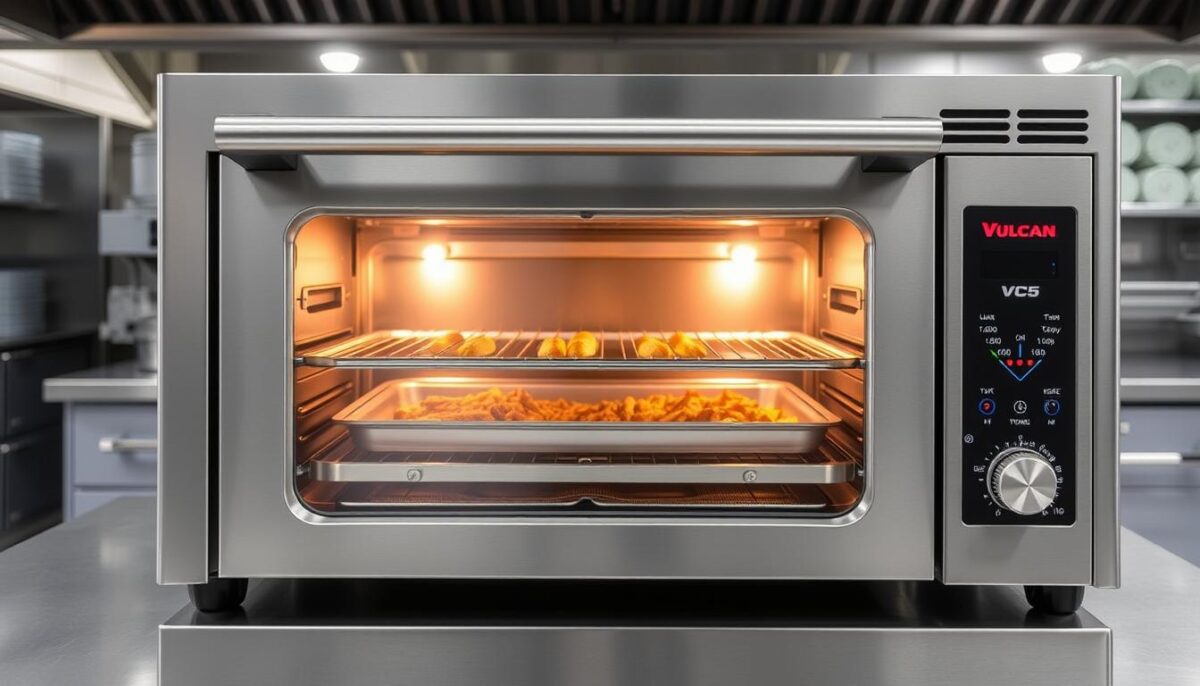
Vulcan VC5 and VC4 Series Features
Vulcan’s VC5 and VC4 Series convection ovens are designed for high-volume commercial kitchens. These models feature advanced heat distribution systems and precise temperature control, ensuring consistent baking results. The VC5 Series offers a range of oven cavity sizes, including single, double, and triple cavity configurations, allowing for flexibility in kitchen design.
The VC4 Series, on the other hand, features a more compact design, making it ideal for smaller kitchens. Both series are constructed with stainless steel exteriors and have porcelain-coated interiors, ensuring durability and ease of maintenance.
A comparison of the physical dimensions, oven cavity sizes, and rack configurations between comparable Wolf and Vulcan models reveals differences in capacity and versatility. Wolf’s Challenger XL Series offers a more extensive range of oven cavity sizes, while Vulcan’s VC5 and VC4 Series provide more flexible rack configurations.
The control systems of both brands differ significantly, with Wolf offering a digital interface and Vulcan providing both analog and digital options. The digital interface on Wolf’s models allows for precise temperature control, while Vulcan’s analog controls offer a more traditional cooking experience.
In terms of energy efficiency, both brands have made significant strides in reducing their environmental impact. Wolf’s Challenger XL Series and Vulcan’s VC5 and VC4 Series have achieved ENERGY STAR certification, ensuring that they meet rigorous energy efficiency standards.
Baking Performance Analysis
To determine which convection oven bakes more evenly, we need to examine the baking performance of Wolf and Vulcan ovens. This analysis will cover key aspects such as heat distribution systems, temperature consistency, airflow design, and real-world baking results.
Heat Distribution Systems
The heat distribution system is crucial for even baking. Wolf’s Challenger Series features a unique burner design that promotes uniform heat distribution. In contrast, Vulcan’s approach focuses on a robust gas range system that provides consistent heat output. A comparison of the two systems reveals that Wolf’s design allows for more precise control over heat distribution, potentially leading to more even baking results.
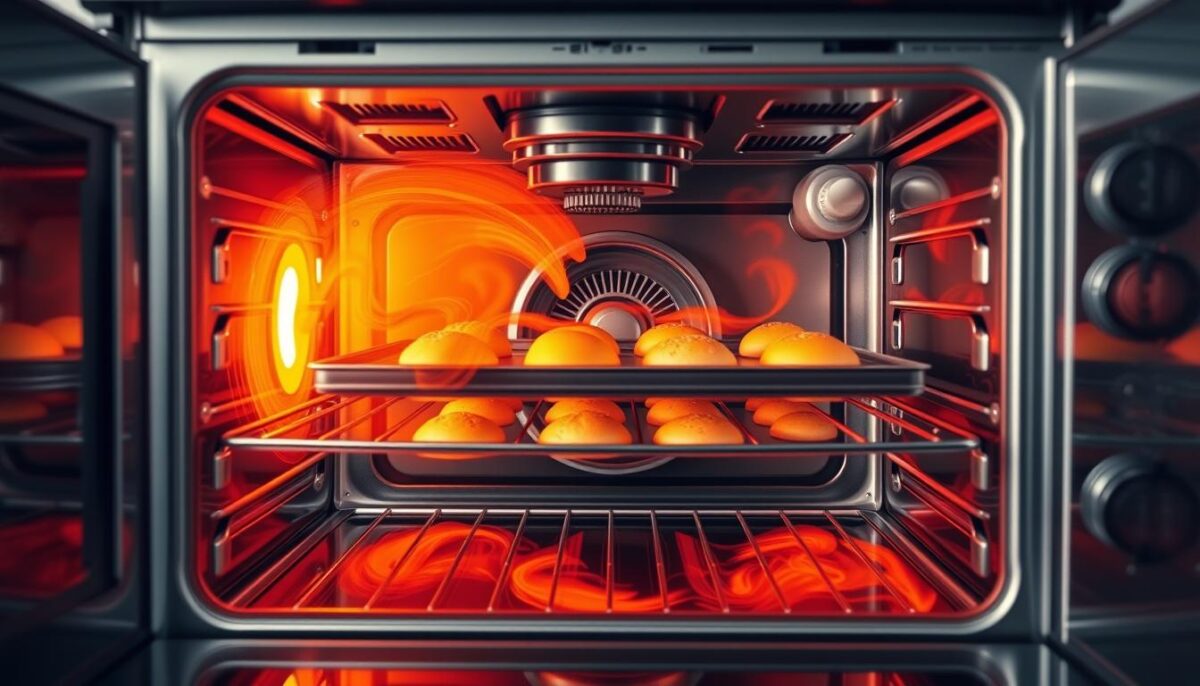
Temperature Consistency and Recovery
Temperature consistency is vital for achieving reliable baking results. Both Wolf and Vulcan ovens demonstrate excellent temperature control, but the test revealed that Wolf’s convection oven maintained a more consistent temperature across different rack positions. Recovery times after door openings were also faster in Wolf ovens, which is critical for busy kitchens.
Airflow Design and Impact on Evenness
The airflow design within a convection oven significantly impacts baking evenness. Vulcan’s ovens feature a sophisticated fan design that circulates hot air efficiently, minimizing hot spots. However, Wolf’s Challenger Series oven’s airflow system was found to provide a more uniform air circulation pattern, contributing to better overall baking performance.
Real-World Baking Results
In real-world baking tests, both ovens performed well, but with some notable differences. Wolf’s oven produced more consistent results across various baked goods, from delicate pastries to dense breads. The test results are summarized in the following table:
| Baked Good | Wolf Oven Result | Vulcan Oven Result |
|---|---|---|
| Delicate Pastry | Excellent evenness | Good, minor hot spots |
| Dense Bread | Consistent crust color | Slight variation in crust color |
| Croissants | Uniform layering | Good layering, minor inconsistencies |
The baking performance analysis clearly shows that both Wolf and Vulcan convection ovens have their strengths. However, Wolf’s Challenger Series oven demonstrated a slight edge in terms of overall baking evenness and consistency.
Practical Considerations Beyond Evenness
When choosing between Wolf and Vulcan convection ovens, it’s crucial to consider factors beyond just even baking performance. While baking evenness is essential, other practical aspects can significantly impact your overall satisfaction and operating costs.
Energy Efficiency and Operating Costs
Energy efficiency is a critical factor in the long-term cost of owning a convection oven. I compared the energy efficiency ratings between Wolf and Vulcan models, focusing on their potential operating cost differences over the equipment’s lifetime. Wolf’s Challenger series is designed with energy efficiency in mind, potentially reducing operating costs. The energy efficiency of these ovens not only affects your utility bills but also their environmental impact.
Key Energy Efficiency Features:
- Advanced insulation materials
- Efficient gas ignition systems
- Optimized burner designs
Durability and Maintenance Requirements
The durability and maintenance needs of a convection oven are vital for its long-term performance. I examined the construction quality, including door hinge durability and interior coating longevity, for both Wolf and Vulcan ovens. The porcelain-coated interiors in both brands offer resistance to corrosion and ease of cleaning, though their durability can vary.
Price Point and Value Analysis
Comparing the price points of Wolf and Vulcan convection ovens involves more than just the initial purchase cost. I analyzed the total cost of ownership, including installation expenses, maintenance costs, and the cost of replacement parts over time. While Wolf ovens may have a higher upfront cost, their durability and performance can provide long-term value.
Key Considerations for Total Cost of Ownership:
- Initial purchase price
- Installation costs, including any necessary ventilation or gas line upgrades
- Maintenance and repair costs over the equipment’s lifespan
By considering these practical factors, you can make a more informed decision that aligns with your kitchen’s needs and budget.
Conclusion: Making the Right Choice for Your Kitchen
As we conclude our comparison of Wolf and Vulcan convection ovens, it’s clear that both brands offer exceptional baking performance. The key differences lie in their technical specifications, baking evenness, and practical considerations.
Wolf convection ovens excel in terms of precise temperature control and advanced airflow design, making them ideal for delicate pastries and precise baking tasks. On the other hand, Vulcan convection ovens offer robust performance, durability, and a more affordable price point, suiting high-volume commercial kitchens.
When choosing between these two brands, consider your specific baking needs and kitchen environment. If you prioritize even baking and are willing to invest in premium equipment, Wolf might be the better choice. However, if you’re looking for a reliable, high-performance convection oven at a competitive price, Vulcan is worth considering.
Ultimately, the decision comes down to your kitchen’s unique requirements, budget constraints, and the type of baking you do most often. By weighing factors such as energy efficiency, durability, and total ownership experience, you can make an informed decision that meets your needs.
FAQ
What are the key differences between the Wolf Challenger Series and Vulcan’s VC5 and VC4 Series?
The Wolf Challenger Series and Vulcan’s VC5 and VC4 Series differ in their technical specifications, including BTU output, burner configuration, and griddle standard options. The Wolf Challenger Series features six open top burners, while Vulcan’s VC5 and VC4 Series offer varying configurations to suit different kitchen needs.
How do I ensure even baking in my commercial convection oven?
To achieve even baking, it’s essential to understand the heat distribution system and airflow design of your oven. Regular maintenance, proper rack configuration, and adequate temperature consistency and recovery are also crucial.
What are the benefits of using a gas range with a stainless steel finish?
A gas range with a stainless steel finish offers durability, resistance to corrosion, and ease of cleaning. The stainless steel construction also provides a sleek, professional appearance that complements any commercial kitchen.
Can I upgrade my existing oven to improve energy efficiency?
Yes, you can upgrade your existing oven to improve energy efficiency by installing new racks, optimizing your cooking techniques, or replacing your oven with a more energy-efficient model. Regular maintenance, such as cleaning the oven interior and checking for worn-out parts, can also help reduce energy consumption.
What are the advantages of having casters on my commercial cooking equipment?
Having casters on your commercial cooking equipment provides flexibility and ease of movement, making it simpler to clean, maintain, and reconfigure your kitchen layout as needed.
How do I choose the right gas model for my kitchen?
To choose the right gas model, consider factors such as your kitchen’s energy requirements, available space, and cooking needs. Research different models, read reviews, and compare features to find the best fit for your commercial kitchen.
